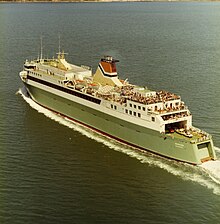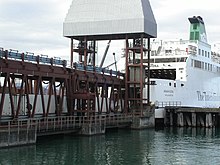Arahura (ship, 1983)
|
The Arahura in front of Pencarrow Head, February 2007
|
||||||||||||||||||||||||||||||
|
||||||||||||||||||||||||||||||
|
||||||||||||||||||||||||||||||
|
||||||||||||||||||||||||||||||
|
||||||||||||||||||||||||||||||
|
||||||||||||||||||||||||||||||
The Arahura was a rail ferry of the New Zealand shipping company Interislander put into service in 1983 . The ship was in service on the Wellington to Picton route for more than thirty years before being retired in July 2015 and sold to India for scrapping in October 2015 . At the time of its commissioning, the Arahura was the largest passenger ship under the New Zealand flag. During its service life, the ferry completed more than 50,000 crossings through the Cook Strait .
history
Planning and construction
The New Zealand Ministry of Transport decided to build the Arahura in 1981. Aalborg Værft in Aalborg was finally able to prevail among various shipyards in Europe and Asia , where the ship was laid down under hull number 245 and launched on March 18, 1983. The Arahura was designed by the British naval architect Burness Colett. The ship was designed as a replacement for the two smaller ferries Aramoana and Aranui , which ended their service in 1984 and changed owners. The Arahura was commissioned by the New Zealand Ministry of Transport for the state-owned New Zealand Railways and was the first state-owned new building since the Aratika in 1974. The name Arahura comes from the Maori language and means " way to dawn" . Furthermore, a city and a river in New Zealand bear this name. From 1905 to 1952 there was already a small passenger ship called Arahura , which was managed by the Union Steam Ship Company and later by the Anchor Line .
On November 12, 1983, the ferry was taken over by New Zealand Railways, after which the ship was transferred to New Zealand.
period of service
On December 13, 1983, the Arahura was put into service on the route from Wellington to Picton. At the time of her commissioning, she was the largest passenger ship in New Zealand and was only trumped in length by the Aratere in 1998 (and after its conversion in 2011 also in tonnage) and was thus replaced in this position. The Arahura stood upon delivery mainly by compared to other ferries on this route high service speed and a modern bridge system out. The ship's bulbous bow was also considered an innovation.
In February 1986 the Arahura evacuated the passengers and crew of the Soviet cruise ship Mikhail Lermontov , which hit an unrecorded rock in front of the Marlborough Sounds and sank a few hours later.
In 1989 the Arahura was the first ship in the Interislander fleet to be repainted. The previously green hull of the ship was painted white. From then on there was a picture of Pelorus Jack on the chimney , a round-headed dolphin who chased ships through the Cook Strait from 1888 to 1912 and thus became famous.
On April 11, 1989, the Arahura was hit by a storm during a crossing off Wellington, which reached a speed of up to 111 km / h. The strong waves caused the ship to roll 41 degrees to one side, injuring several passengers and damaging vehicles on the car deck.
From 1996 the ship, previously managed directly by New Zealand Railways, was used for Interislanders. On August 23, 2004, the Arahura arrived in Hobart to be modernized for a total of 4.5 million New Zealand dollars . On September 23, 2004, the ship finally returned to service.
On April 30, 2008 the Arahura interrupted the service for several months in order to be rebuilt in Singapore in May 2008 . In doing so, the hull was painted again as well as a new logo in the chimney. After completion of the renovation work, the ship became the property of Kiwi Rail, a member of New Zealand Railways, which put it back into service on its old route on September 28, 2008.
On June 26, 2014, the Arahura reached 50,000 crossings through the Cook Strait. She covered a distance of more than 4.6 million kilometers. At the beginning of September 2014, the ship was given a general overhaul in the dry dock at Devonport Naval Base in Auckland for three weeks in order to enable operation for another year. On September 22nd, the Arahura returned to regular service.
Retirement and demolition
In December 2014, the planned decommissioning of the Arahura for mid-2015 was announced. InterIslander had been looking for a replacement for the aging ship for three years and found one in Stena Line's Stena Alegra, which was put into service in 1998 . On July 29, the Arahura made her last crossing after more than three decades in service. Due to new regulations, the ship was no longer allowed to carry passengers. An upgrade to continue passenger operations would have cost $ 25 million. On 30 July 2015, was Arahura retired and reflecting in Kaiarahi renamed Stena Alegra replaced.
On October 3, 2015, the ship became the property of an Indian scrapping yard. In September it was renamed Ahura for the demolition trip and registered on the Palau Islands with Malakal as the home port. On November 3, 2015, the former Arahura arrived in Alang , where it was completely scrapped by January 2016.
In its almost 32 years of service, the ship carried more than ten million passengers in over 50,000 crossings. Because of his long service, it was nicknamed Quiet Achiever ( quiet achiever ).
Machine system
The Arahura was with four diesel engines of the type Wärtsilä equipped -Vasa V32, which had a power output of 3,800 kW and were connected to four GEC electric motors. This made it one of only a few ferries with a diesel-electric drive. The ship's top speed was just under twenty knots. The drive of the Arahura consisted of two controllable pitch propellers from Karlstads Mekaniska Werkstad . The ship's fuel tanks had a capacity of up to 450,000 liters. The generators on board achieved an output of up to 14 megawatts.
Particularly in the last years of service, the Arahura's machinery was considered expensive. In the daily service 50 tons of fuel were used, the generators needed an additional five tons daily. For this reason, as of May 2015, the ship's fuel was mixed with low human water for savings.
Furnishing
The Arahura's passenger facilities were located on decks 7 to 9. At the time of its commissioning, the ship had the following facilities:
The entrance area through which the passengers entered the ship was located on deck 7. In addition to the paymaster's office, this deck also housed a play room, a play area for children, a cafeteria, a conference room, three lounges and a bar with an adjoining terrace.
On deck 8, in addition to a cinema in the stern area, a music lounge and the senior citizens lounge were housed. In the front area there was a viewing lounge and a children's area with an ice bar. Deck 8 also had two promenade decks on the star and port sides.
Deck 9 consisted of a so-called sun lounge and several open deck areas with seating.
In the course of her service, the interior of the Arahura was modernized and changed several times. In later years it was given a room called the Timezone with video games and a Club Class Lounge . The viewing lounge on deck 8 was named Queen Charlotte Cafe & Bar .
The vehicle decks of the ship, distributed on deck 3 and deck 5, had capacity for up to 100 cars and 60 railway wagons. The road and rail vehicles were loaded from the stern. A loading ramp consisting of two floors was used here.
literature
- Wave rolls Arahura 40 degrees in wild strait. In: The Evening Post , Fairfax Media , Wellington, April 12, 1989.
Web links
- the ship on faktaomfartyg.se (Swedish)
- the ship on ferry-site.dk (English)
- the ship on the side of the New Zealand National Maritime Museum (English)
Individual evidence
- ^ A b H. Forsman: Arahura - Travel Report (Swedish). In: The Motor Vessel. October 27, 2012, accessed April 15, 2019 .
- ↑ Gavin McLean: The Arahura. In: TEARA The Encyclopedia of New Zealand. March 11, 2010, accessed April 15, 2019 .
- ^ Sophie Lee: Arahura celebrates 30 years' service. In: Kiwi Rail. December 13, 2013, accessed April 15, 2019 .
- ^ NZ National Maritime Museum: The Last Cruise of the Mikhail Lermontov. In: The New Zealand Maritime Record. Retrieved April 15, 2019 .
- ↑ Wave rolls Arahura 40 degrees in wild strait. In: The Evening Post , April 12, 1989.
- ↑ NIWA: April 1989 Wellington Storm (1989-04-11). In: NZ Historic Weather Events Catalog. 2018, accessed April 15, 2019 .
- ↑ KiwiRail: Happy berth-day, Arahura. In: Scoop Media. June 25, 2014, accessed April 15, 2019 .
- ↑ Interislander Ferry “Arahura” Homeward Bound. In: New Zealand Rent a Car. September 22, 2014, accessed April 15, 2019 .
- ↑ Catherine Hutton: KiwiRail calls time on Arahura ferry. In: Radio New Zealand. December 9, 2014, accessed April 15, 2019 .
- ↑ Emily Cooper: Interislander ferry Arahura sails into retirement. In: Newshub. July 29, 2015, accessed April 15, 2019 .
- ↑ Raoul Fiebig, Frank Heine, Frank Lose: The great passenger ships of the world: The great passenger ships of the world . Koehlers Verlagsgesellschaft , Hamburg 2016, ISBN 978-3-7822-1245-8 , page 286.
- ↑ Chloe Winter: Overseas buyer snaps up ex-Interislander ferry Arahura. In: Stuff. October 4, 2015, accessed April 15, 2019 .
- ^ Joel Maxwell: Interislander ferry Arahura mixes water with fuel to cut costs. In: Stuff. May 27, 2015, accessed June 30, 2020 .
- ↑ Arahura (1983) 1984 deck plan. In: hhvferry.com. Retrieved April 15, 2019 .
- ↑ Arahura (1983) 2008 deck plan. In: hhvferry.com. Retrieved April 15, 2019 .



